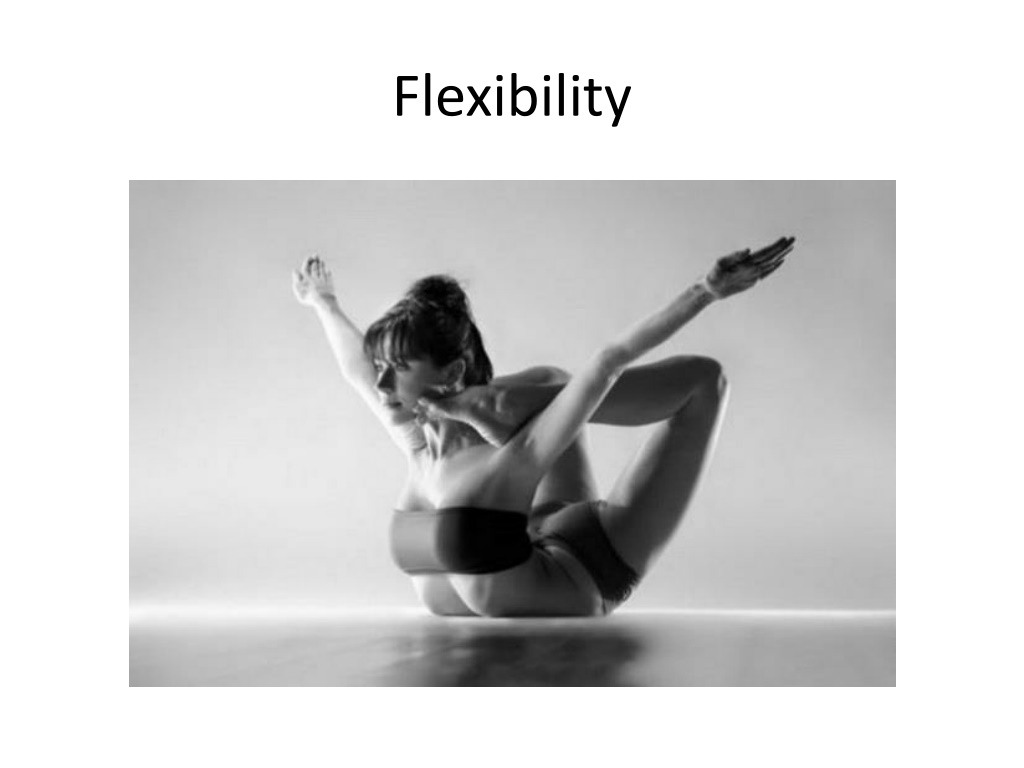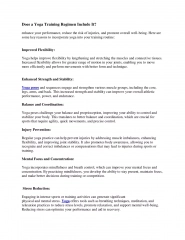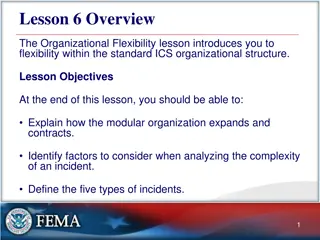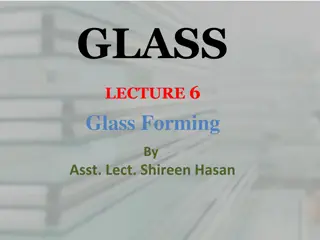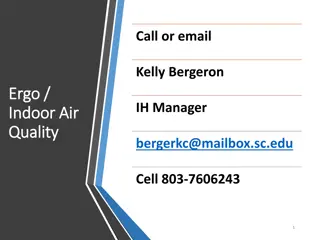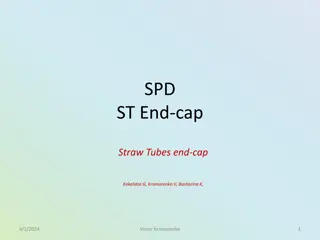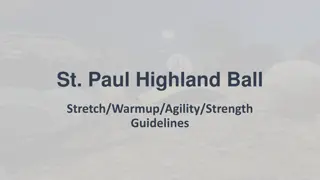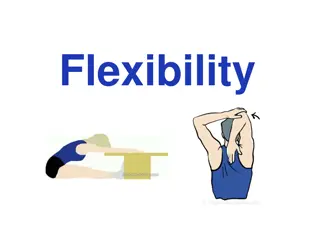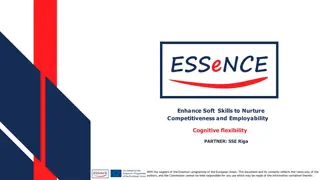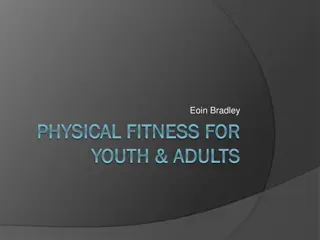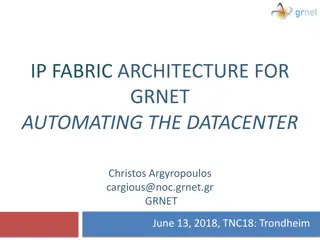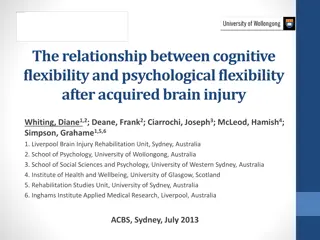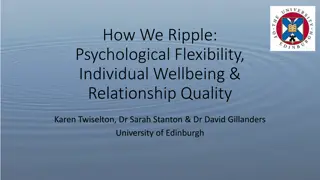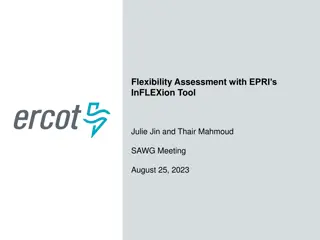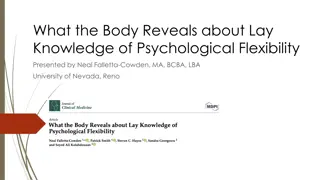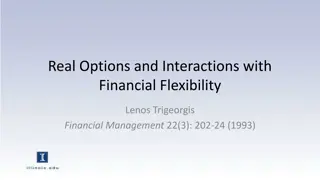Understanding Flexibility and Stretching Techniques
Flexibility is crucial for optimal physical performance and injury prevention. It refers to the ability to move joints through a full range of motion without restrictions. Factors limiting flexibility include tissue elasticity, bony structure, and muscle/tendon extensibility. Understanding active and passive range of motion, along with goniometry for measurement, is essential. Learning targets encompass defining flexibility, exploring stretching techniques, and understanding the neurophysiological basis of flexibility. Various stretching techniques and their benefits are key to enhancing flexibility and overall physical well-being.
Download Presentation

Please find below an Image/Link to download the presentation.
The content on the website is provided AS IS for your information and personal use only. It may not be sold, licensed, or shared on other websites without obtaining consent from the author. Download presentation by click this link. If you encounter any issues during the download, it is possible that the publisher has removed the file from their server.
E N D
Presentation Transcript
Learning Targets I can define flexibility and the things that limit Range of Motion I can explain the agonist/antagonist relationship between muscles I can compare and contrast the 5 different stretching techniques I can describe how to perform the 3 different PNF techniques I can explain the neurophysiological basis for flexibility and stretching as it applies to each stretching technique
Flexibility Defined Flexibility: the ability to move a joint or series of joints through a full, nonrestricted, pain-free range of motion Can be discussed in relation to a single joint or a series of joints Restricted range of motion can decrease performance capabilities E.g. losing speed because hamstrings restrict hip flexion decreasing stride length; awkward or uncoordinated movement patterns
Factors that Limit Flexibility Elasticity: tissue s ability to return to its resting length Extensibility: ability to stretch beyond a tissue s normal length Bony structure Fat Skin Muscles and tendons Connective tissue/contractures Lose elasticity and shorten when immobilized
Active ROM Active ROM (also called Dynamic Flexibility) Degree which a joint can be moved by a muscle contraction Not a good indicator of flexibility because it applies to the ability to move a joint efficiently, with little resistance to motion. Required to perform sporting activities Need full knee extension to hurdle and for full stride length
Passive ROM Passive ROM (also called Static Flexibility) Degree which a joint can be passively moved to the endpoints in the ROM. No muscle contraction is involved. Can move farther than active ROM Important for injury prevention; allows muscle to stretch to prevent injury to the musculotendinous unit
Goniometry Goniometer A large protractor with measurement in degrees Align individual arms of goniometer parallel with the longitudinal axis of the two segments involved in motion about a specific joint.
Stretching Techniques Flexibility is important for successful physical performance and injury prevention Goal of a flexibility program is to improve ROM at given articulation by altering extensibility of the musculotendinous unit that produce movement at that joint.
Stretching Techniques Agonist v. Antagonist Muscles (Hero v. Villian) Muscles that perform a specific action are called agonist muscles (e.g. quads perform knee extension) Muscles that are being stretched in response to the contraction of the agonist are antagonist muscles (e.g. hamstrings stretched in knee extension)
Stretching Techniques Muscles that work in concert with one another are called synergistic muscle groups (e.g. all four quadriceps muscles) Balance must exist between agonist and antagonist muscles to allow for coordinated movement, as well as reduce the chance of muscle strain or imbalances.
Stretching Techniques: Ballistic Ballistic Stretching Bouncing movements; repetitive contractions of the agonist muscle are used to produce quick stretches of the antagonist muscle. Concern that somewhat uncontrolled forces within the muscle may exceed extensibility limits in the muscle fiber, thus producing small microtears in the musculotendinous unit.
Stretching Techniques: Ballistic May be true in sedentary or athletes with muscular injury but not usually a concern in healthy athletes. Most sports are dynamic and require ballistic movements e.g. forcefully kicking a soccer ball 50 times requires contraction of the quadriceps to extend the knee and requires the hamstrings to decelerate the lower leg via eccentric contractions. Ballistic stretching would prepare the hamstrings for this type of activity.
Stretching Techniques Static Stretching Involves passive stretching of the antagonist by placing it in a maximal position and holding it for an extended period of time. Research has shown that holding a static stretch for 15 seconds is as effective as holding it for 2 minutes. Research indicates that for maximal effectiveness over time static stretches should be repeated 3-5 times for each muscle being stretched.
Stretching Techniques Static Stretching (continued) Can be accomplished by using a contraction of the agonist muscle, body weight, a partner, or a T-bar or pole (primarily for upper body) Research has shown that static and ballistic stretching are equally effective for improving flexibility, however there seems to be less danger of exceeding extensibility limits with static stretching. Ballistic stretching is better indicated as part of a warm-up as it more mimics dynamic activity.
Stretching Techniques Proprioceptive Neuromuscular Facilitation Techniques called slow- reversal-hold-relax, contract- relax, and hold-relax Utilize isotonic and isometric contractions and relaxation of both agonist and antagonistic muscles Best with a partner but can be used with a wall for resistance.
Neurophysiological Basis of Stretching All three techniques involve the neurophysiological phenomenon involving the stretch reflex. Mechanoreceptors send messages to the CNS of what is happening to the muscle. Two of the mechanoreceptors that are important in the stretch reflex are the muscle spindle and Golgi tendon organ.
Muscle Spindle Sensitive to changes in muscle length. When a muscle is stretched sensory impulses are sent to the CNS informing it that the muscle is being stretched. Return impulses from the spinal cord to the muscle causing the muscle to reflexively contract, thus resisting the stretch. If the stretch continues for at least 6 seconds the Golgi Tendon Organ responds.
Golgi Tendon Organ Affected by changes in muscle length and muscle tension. If the stretch continues for at least 6 seconds the Golgi Tendon Organ responds by causing a reflex relaxation of the antagonist muscle This protects the muscle and allows it to stretch through relaxation before extensibility limits are exceeded.
Neurophysiology Applied Ballistic Stretching Repetitive bouncing repeatedly stretch the Muscle Spindles Ballistic stretching is not held long enough to allow the GTO to have a relaxing effect. This stretching targets other tissues to help improve ROM Static Stretching Involves sustained stretch lasting from 6-60 seconds This allows the GTO to respond to increased tension GTO overrides impulses from Muscle Spindle allowing the muscle to relax.
Neurophysiology Applied PNF It takes advantage of the same neurophysiological principles and two additional techniques. Autogenic Inhibition A maximal isometric contraction of the muscle that will be stretched during a 10 second push phase increases tension that stimulates the GTO This causes a reflexive relaxation response in the antagonist muscle even before it is placed into a stretched position Relaxation of the antagonist muscle during contractions is referred to as autogenic inhibition
Neurophysiology Applied Reciprocal Inhibition In any synergistic muscle group, a contraction of the agonist causes a reflex relaxation of the antagonist muscle. An additional passive stretch during the isometric contraction of the agonist pulling the extremity further into the agonist pattern elicits an additional relaxation reflex of the antagonist muscle. This is called reciprocal inhibition.
PNF: Contract-Relax Technique Contract-Relax Start with a Passive Stretch for 15 seconds Repeat the following pattern3-5 times ending on passive stretch: Verbal Command Push contracting the antagonist muscle being stretched for 10 seconds Verbal Command Relax and move into a deeper passive stretch Repeat 3-5 times ending on passive stretch for 10-15 seconds
PNF: Hold-Relax Technique Hold-Relax Start with a Passive Stretch for 15 seconds Repeat the following pattern3- 5 times ending on passive stretch: Verbal Command Pull contracting the agonist muscle for 10 seconds Verbal Command Relax and move into a deeper passive stretch for 10-15 seconds
PNF: Slow Reversal-Hold-Relax Technique Contract-Hold-Relax Start with a Passive Stretch for 15 seconds Repeat the following pattern3- 5 times ending on passive stretch: Verbal Command Push contracting the antagonist muscle being stretched for 10 seconds Verbal Command Pull contracting the agonist muscle for 10 seconds Verbal Command Relax and move into a deeper passive stretch for 10-15 seconds
Guidelines and Precautions for Stretching Warm-up low intensity to high large gross motor movements to sports specific multi joint Why increase blood flow increase body temp increase extensibility increase respiration/O2 intake lubricate joints increase heart rate remove waste increase mental acuity excite nervous system
Guidelines and Precautions for Stretching To increase flexibility, a muscle must be overloaded and stretched beyond its normal ROM but not to the point of pain. Stretch only to the point of tightness or resistance; NO PAIN! Increases ROM will be specific to whatever muscle or joint is being stretched. Be careful when stretching painful joints. Pain is the body s way of letting you know something is wrong.
Guidelines and Precautions for Stretching Avoid overstretching Exercise caution when stretching the neck and low back. Exercises that compress the vertebrae and discs can cause damage. To reduce stress on the low back, stretch in a seated position Stretch muscles that are tight and inflexible Strengthen loose muscles
Guidelines and Precautions for Stretching Apply stretches that are appropriate to the person and/or activity. Breathe normally Should be done at least 3 times/week for minimal improvement; 5-6 times/week for maximal improvement
